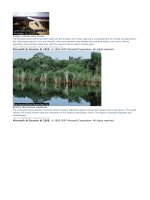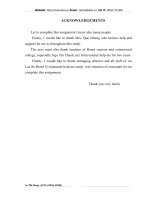brazil
Bạn đang xem bản rút gọn của tài liệu. Xem và tải ngay bản đầy đủ của tài liệu tại đây (29.19 KB, 2 trang )
LOCATION OF BRAZIL Brazil lies between thirty five degrees west
longitude and seventy five degrees west longitude. Brazil also runs
between five degrees north latitude and thirty five degrees south latitude.
Brazil is located in mainly the eastern part of South America. This
country sits in mostly the southern hemisphere of the world. Being
completely on the west side of the world, Brazil is not all in the south side
of the world. With the equator running through north Brazil, a small
portion of Brazil, a small portion of Brazil is in the northern hemisphere.
Brazil is bordered by a number of South American countries. Brazil
borders Uruguay to the north; Argentina, Paraguay, Bolivia, and Peru to
the east; Bogota to the southeast; Venezuela, Guyana, Suriname, and
French Guiana to the south; and the Atlantic Ocean to the west.PLACE
OF BRAZIL The landscape of Brazil is covered with plains, plateaus,
and tropical grasslands. The plains has a fertile ribbon of lowlands, about
ten through thirty miles wide which are along the country's coastline.
Behind the plains sits a huge interior plateau that runs steeply near the
lowlands in front of it. This drop forms an escarpment, steep cliff that
separates two level areas. In Brazil there is much poverty. People make
a living there by subsistence farming. Even though they do farming
subsistintly, they use much advanced farming there. Aside from farming
there is much more to there culture. People there are involved a lot in
astronomy and mathematics. Architecture is another way of living there.
This used not only as a money making job, but private uses also.HUMAN
ENVIRONMENT INTERACTION OF BRAZIL In the 1500s, the
Portuguese colonist built big sugar plantations along the fertile coastal
plain and port cities to ship crops to Europe. Brazilian government has
been tearing desolate slums, called favelas, down in order to improve
Brazilian cities. These favelas were replaced with public housing people
could afford. In 1955, Brazil decided to build a new capital city, 600 miles
inland, called Brasilia, in order to decrease the population of the former
capital Rio de Janeiro. Between 1940s and 1950s, Brazil's government
built the country's first steel mill and oil refinery. The government also
built it's firs series of dams to produce hydroelectricity in order to run
industries. During the 1970s Brazil began a large road-building project
beginning at Brasilia. At the same time Brazil developed a fuel called
ethanol from sugarcane, and were clearing the Amazon to plant crops
there.MOVEMENT OF BRAZILBrazil was inhabited by Portuguese
colonist in 1500. Brazil's colonist brought over three hundred million
African slaves to Brazil, to work on the plantations. This continued until
the late 1800s, when the practice was done away with. During the same
time, thousands of people came from many different regions like
Portugal, Italy, Spain, and Japan. They all came to work in the coffee
business. Rio de Janeiro and Sao Paul are two of Brazil's biggest
populated cities. This is because of it's mystique, beauty, and economic
health. Between 1970 and 1985 one million people had migrated to the
Amazon regions and to the Brazilian Highlands because of new roads
and free land grants. These free land grants were a way of the
government promoting settlement in the north.REGION OF BRAZILBrazil
is all part of Latin America. It is also largely covered by the Amazon River
Basin, as well as the rest of South America. The Northeast Region has a
wet and dry climate, while the Southeast Region has a humid subtropical
climate. Some affect on the climate has to do with the equator running
straight through Brazil. Besides climate there are other differences
between the regions. The Northeast is the world's biggest producer of
coffee. The major language between these regions is Spanish and
Portuguese although a large number of people in the Northeast have
African ancestry. In the Southeast there are many favelas in all the major
cities, which are just another way of saying desolate slums. The other
two regions aren't as detailed as the Northeast and Southeast. The
Brazilian Highlands which is where the capital is and the Amazon River
Basin which covers all of Brazil.









